Numerical Investigating on Representativeness of Tracers in PIV Model Test of Dredged Slurry Treated by Vacuum Preloading
Abstract
:1. Introduction
2. Brief Introduction to CFD-DEM Solver
2.1. The Governing Equation of CFD
2.2. The Governing Equation of DEM
3. Verification of the CFD-DEM Solver
3.1. Richardson’ Empirical Formula
3.2. Numerical Model on Particle Sedimentation
4. Numerical Model
4.1. Modeling on PVD Membrane
4.2. Modeling on Slurry and PIV Tracers
4.3. Boundary Conditions
5. Numerical Results
6. Discussions
7. Conclusions
- (1)
- For tracers that are made by carbon powders of mass density 2000 kg/m3 or by sand grains of mass density 2650 kg/m3, the stable displacement ratio (Dt/Ds) between the tracer and the slurry particle varies between 0.935 and 1.137 if the tracer/slurry particle diameter ratio dt/ds and the initial void ratio e0 of the slurry varies in the ranges of 1.6~2.5 and 2~3, respectively. Thus, the representativeness of the tracer is acceptable if compared to the ideal value Dt/Ds = 1, since the largest difference is about 14%.
- (2)
- For tracers made by the carbon powders of diameter within 1.8 times the median size of the slurry particles, the representativeness of the PIV tracers can be significantly improved since the displacement ratio Dt/Ds varies in the small range of 0.935~1.05, i.e., the largest difference is only about 6.5%.
- (3)
- Generally speaking, the representatives of the PIV tracers on the displacements of the slurry particles can be improved for tracers of dt/ds closer to 1 and for slurries of lower initial water content, i.e., lower initial void ratio e0.
Author Contributions
Funding
Conflicts of Interest
Abbreviations
| Φs | the solid volume fraction |
| Φf | fluid volume fraction |
| Us | the velocity of the particle |
| Uf | the fluid velocity |
| ∇p | the pressure gradient |
| τ | the viscous stress tensor |
| ρf | the density of the fluid |
| ffp | the volumetric interaction force acting on the fluid by the particles within each cell |
| g | the acceleration of gravity |
| fcol | the contact force between the particles or between the particle and the fixed boundary |
| ffp | the fluid-particle interaction force |
| I | the angular moment of inertia of particles |
| φ | the angular velocity of the particle |
| Tcol | the torque due to the collision between particles |
| Tfp | the torque due to the particle-fluid interactions |
| cf | the volume fraction of the fluid |
| cs | the volume fraction of the solid |
| V(s,c) | the settling rate when the concentration of suspended particles is c |
| V(s,0) | the settlement rate of a single suspended particle |
| n | the empirical parameter in different fluid states |
| d | the diameter of spherical particles |
| D | the diameter of the model vessel |
| Re | known as Reynolds number |
| v | the dynamic viscosity of the fluid |
References
- Chu, J.; Yan, S.; Yang, H. Soil improvement by the vacuum preloading method for an oil storage station. Géotechnique 2000, 50, 625–632. [Google Scholar] [CrossRef]
- Indraratna, B.; Bamunawita, C.; Khabbaz, H. Numerical modeling of vacuum preloading and field applications. Can. Geotech. J. 2004, 41, 1098–1110. [Google Scholar] [CrossRef]
- Cai, Y.; Xie, Z.; Wang, J.; Wang, P.; Geng, X. New approach of vacuum preloading with booster prefabricated vertical drains (PVDs) to improve deep marine clay strata. Can. Geotech. J. 2018, 55, 1359–1371. [Google Scholar] [CrossRef]
- Wang, J.; Ni, J.; Cai, Y. Combination of vacuum preloading and lime treatment for improvement of dredged fill. Eng. Geol. 2017, 227, 149–158. [Google Scholar] [CrossRef]
- Lei, H.; Hu, Y.; Zheng, G.; Liu, J.; Wang, L.; Liu, Y. Improved air-booster vacuum preloading method for newly dredged fills: Laboratory model study. Mar. Georesour. Geotechnol. 2020, 38, 493–510. [Google Scholar] [CrossRef]
- Cai, Y.; Qiao, H.; Wang, J.; Geng, X.; Wang, P. Experimental tests on effect of deformed prefabricated vertical drains in dredged soil on consolidation via vacuum preloading. Eng. Geol. 2017, 222, 10–19. [Google Scholar] [CrossRef]
- He, N.; Cui, Y.; Liu, L.; Chen, X.; Feng, Q.; Deng, Y. Colloid effect on clogging mechanism of hydraulic reclamation mud improved by vacuum preloading. Can. Geotech. J. 2019, 56, 611–620. [Google Scholar]
- Shi, L.; Wang, Q.; Xu, S.; Pan, X.; Sun, H.; Cai, Y. Numerical study on clogging of prefabricated vertical drain in slurry under vacuum loading. Granul. Matter 2018, 10, 20–74. [Google Scholar] [CrossRef]
- Cai, Y.; Zhou, Y.; Wang, P.; Shi, L.; Wang, J. Calculation on settlement of dredged slurry treated by vacuum preloading method with consideration. Rock Soil Mech. 2020, 11, 1–10. [Google Scholar]
- Sun, R.; Xiao, H. SediFoam: A general-purpose, open-source CFD–DEM solver for particle-laden flow with emphasis on sediment transport. Comput. Geosci. 2016, 89, 207–219. [Google Scholar] [CrossRef] [Green Version]
- Chen, F.; Drumm, E.C.; Guiochon, G. Coupled discrete element and finite volume solution of two classical soil mechanics problems. Comput. Geotech. 2011, 38, 638–647. [Google Scholar] [CrossRef]
- Zhao, J.; Shan, T. Coupled CFD–DEM simulation of fluid–particle interaction in geomechanics. Powder Technol. 2013, 239, 248–258. [Google Scholar] [CrossRef]
- Xu, S.; Sun, R.; Cai, Y.; Sun, H. Study of sedimentation of non-cohesive particles via cfd–dem simulations. Granul. Matter 2018, 20, 4. [Google Scholar] [CrossRef] [Green Version]
- Tao, H.; Tao, J. Quantitative analysis of piping erosion micro-mechanisms with coupled CFD and DEM method. Acta Geotech. 2017, 12, 1–20. [Google Scholar] [CrossRef]
- Sun, H.; Xu, S.; Pan, X.; Shi, L.; Cai, Y. Investigating the jamming of particles in a three-dimensional fluid-driven flow via coupled CFD-DEM simulations. Int. J. Multiph. Flow 2019, 114, 140–153. [Google Scholar] [CrossRef] [Green Version]
- Xu, S.; Sun, H.; Cai, Y.; Geng, X. Studying the orifice jamming of a polydispersed particle system via coupled cfd–dem simulations. Powder Technol. 2020, 368, 308–322. [Google Scholar] [CrossRef]
- Adrian, R.J. Particle-imaging techniques for experimental fluid-mechanics. Annu. Rev. Fluid Mech. 1991, 23, 261–304. [Google Scholar] [CrossRef]
- Yuan, B.; Sun, M.; Wang, Y.; Zhai, L.; Luo, Q. Full 3D displacement measuring system for 3D displacement field of soil around a laterally loaded pile in transparent soil. Int. J. Geomech. 2019, 19, 04019028. [Google Scholar] [CrossRef]
- Ahmed, M.; Iskander, M. Evaluation of tunnel face stability by transparent soil models. Tunn. Undergr. Space Technol. 2012, 27, 101–110. [Google Scholar] [CrossRef]
- Zhang, Z.; Tao, F.; Han, J.; Ye, G.; Cheng, B.; Xu, C. Arching development in transparent soil during multiple trapdoor movement and surface footing loading. Int. J. Geomech. 2021, 21, 04020262. [Google Scholar] [CrossRef]
- Pan, X.; Zhou, L.; Sun, H.; Cai, Y.; Shi, L.; Yuan, Z. Vacuum loading test for high moisture content slurry using particle image velocimetry. J. Zhejiang Univ. Eng. Sci. 2020, 54, 1078–1085. [Google Scholar]
- Cai, Y. Consolidation mechanism of vacuum preloading for dredged slurry and anti-clogging method for drains. Chin. J. Geotech. Eng. 2021, 43, 201–225. [Google Scholar]
- Richardson, J.F.; Zaki, W.N. Sedimentation and Fluidization: Part, I. Chem. Eng. Res. Des. 1997, 75, S82–S100. [Google Scholar] [CrossRef]
- Narejo, D.B. Opening size recommendations for separation geotextiles used in pavements. Geotext. Geomembr. 2003, 21, 257–264. [Google Scholar] [CrossRef]
- Liu, L.; Chu, C. Modeling the slurry filtration performance of nonwoven geotextiles. Geotext. Geomembr. 2006, 24, 325–330. [Google Scholar] [CrossRef]
- Tang, L. Pore Size Characteristics and Filtration Properties of Geotextiles Subjected to Tensile Strains; Zhejiang University: Hangzhou, China, 2014. [Google Scholar]
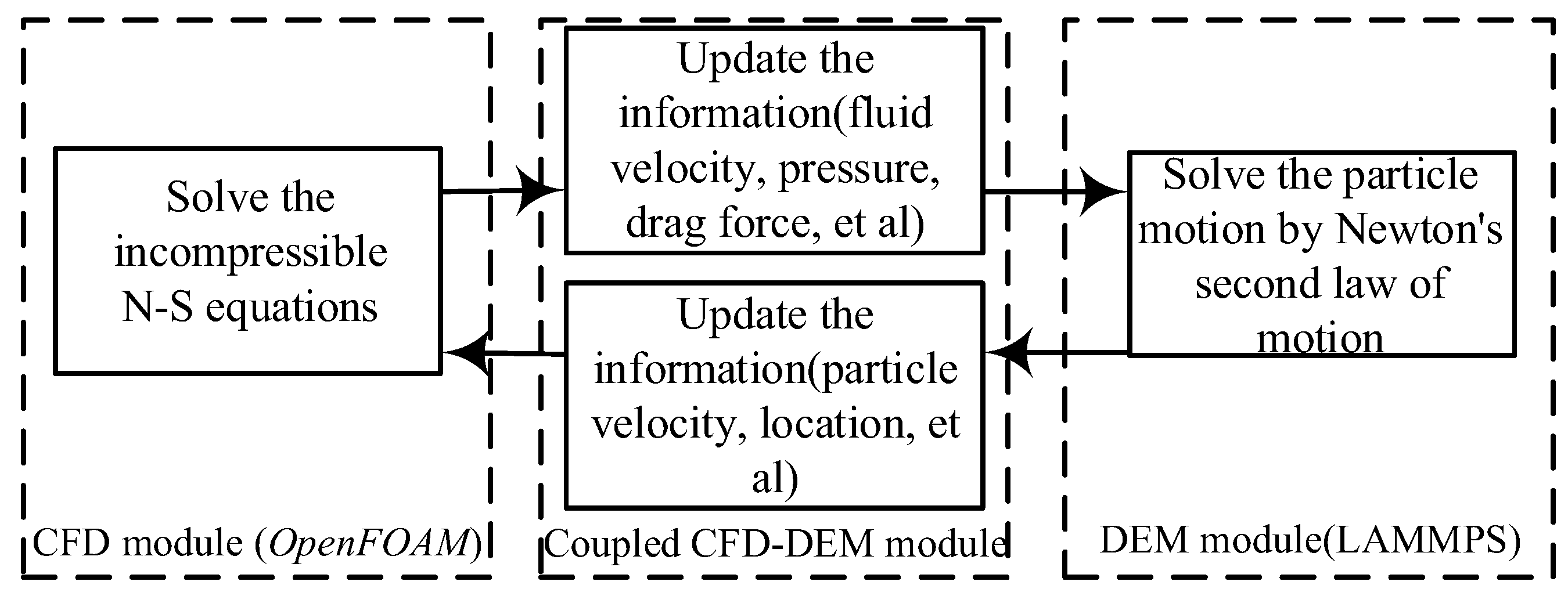
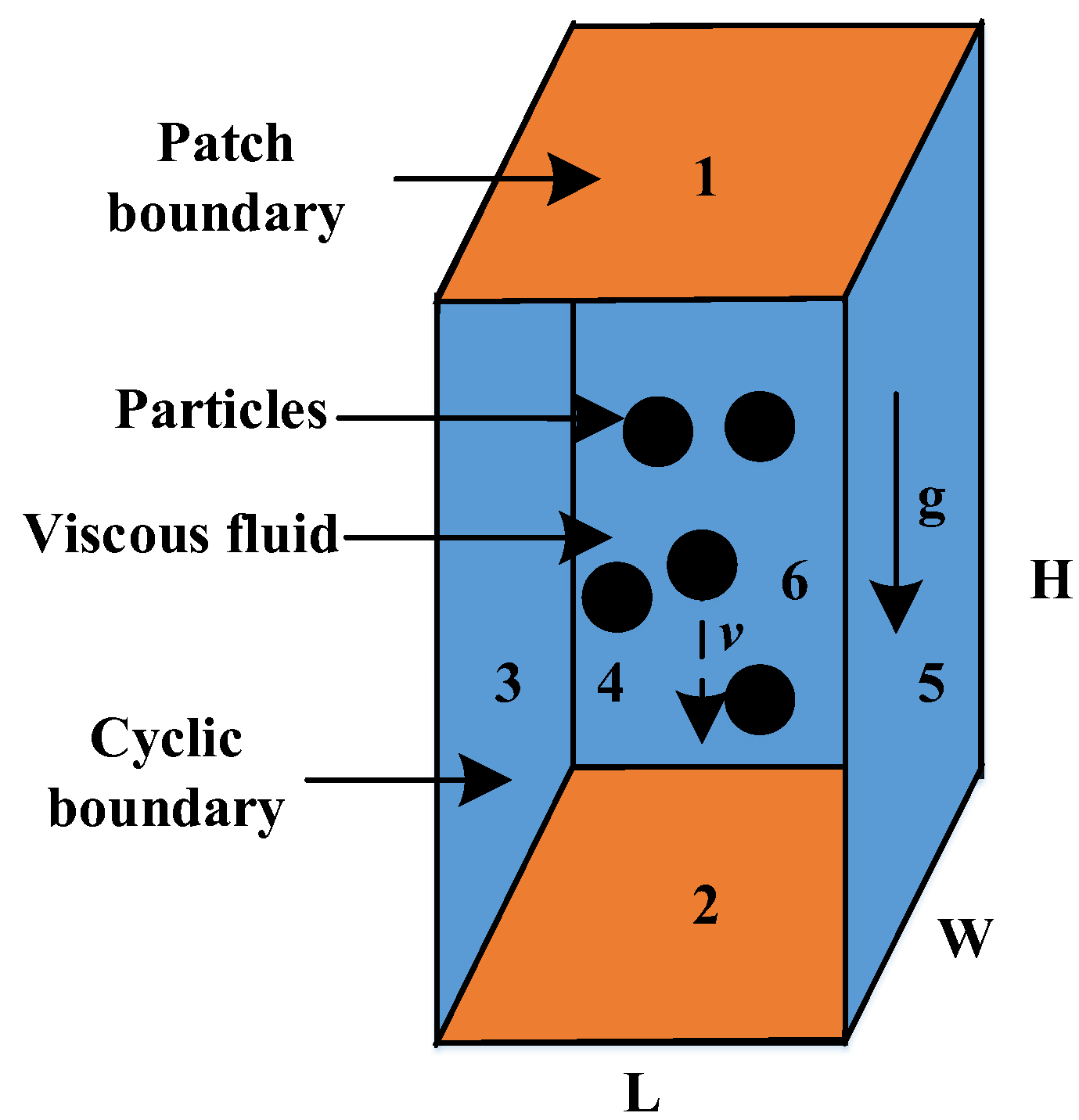



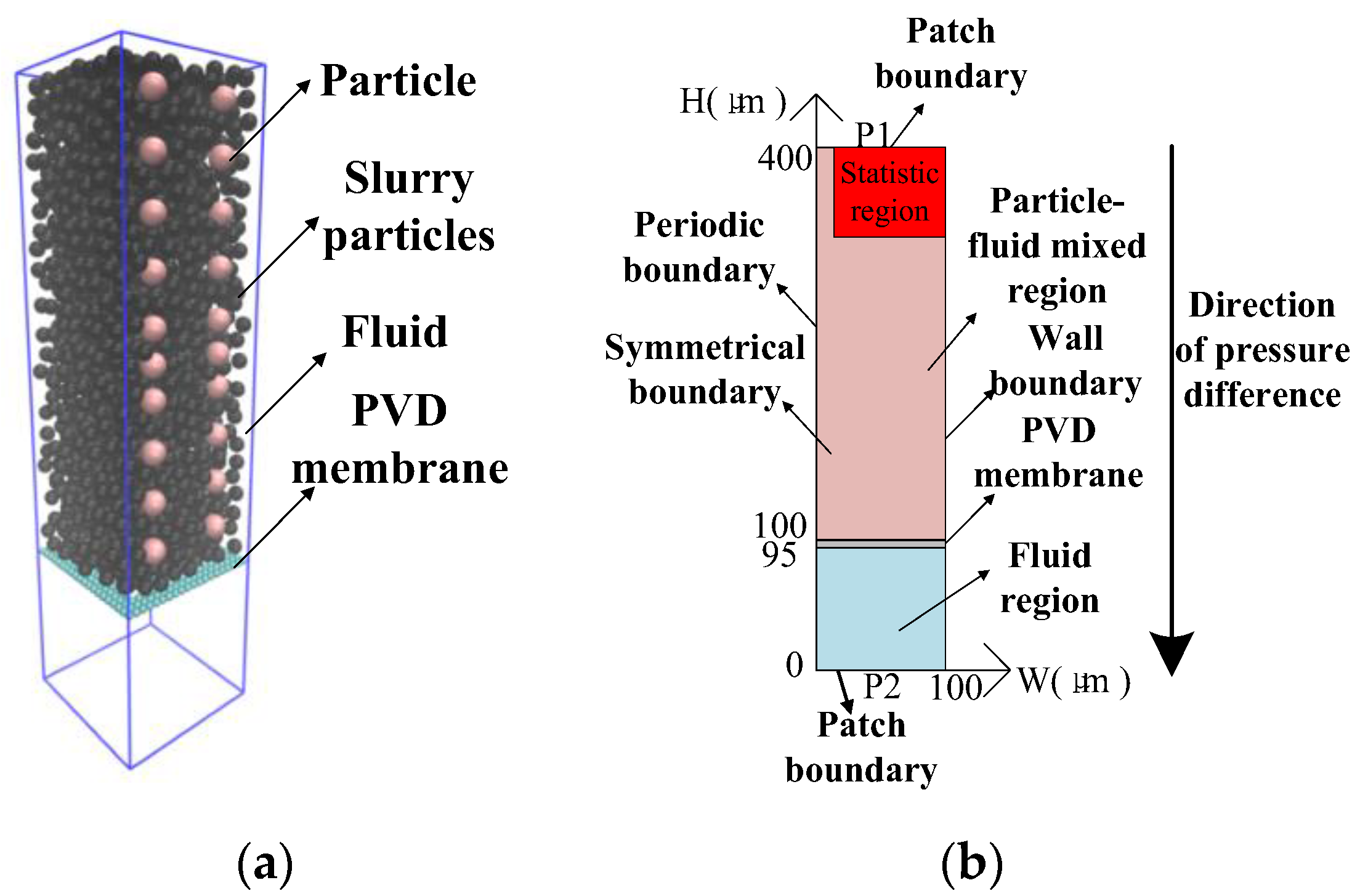
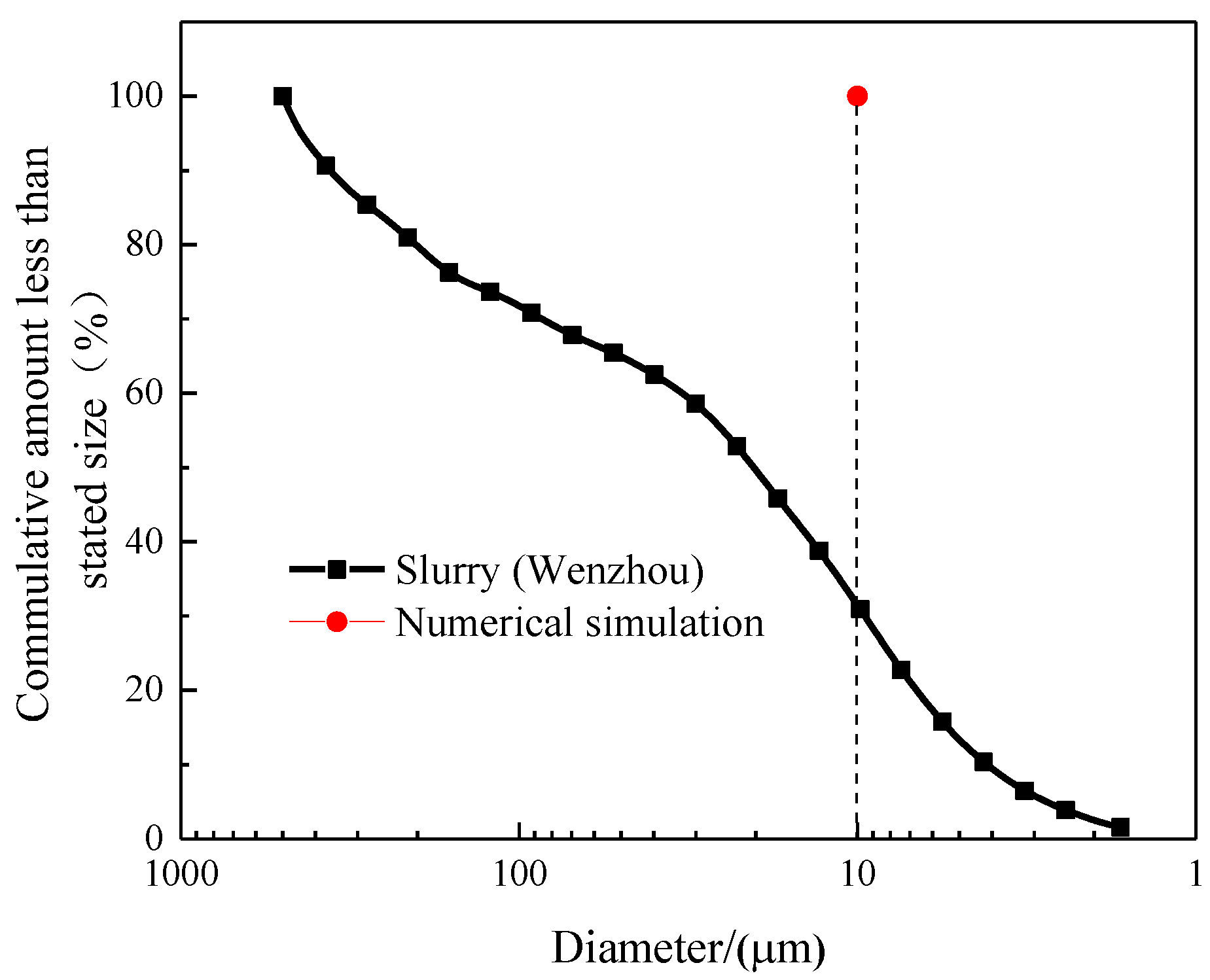



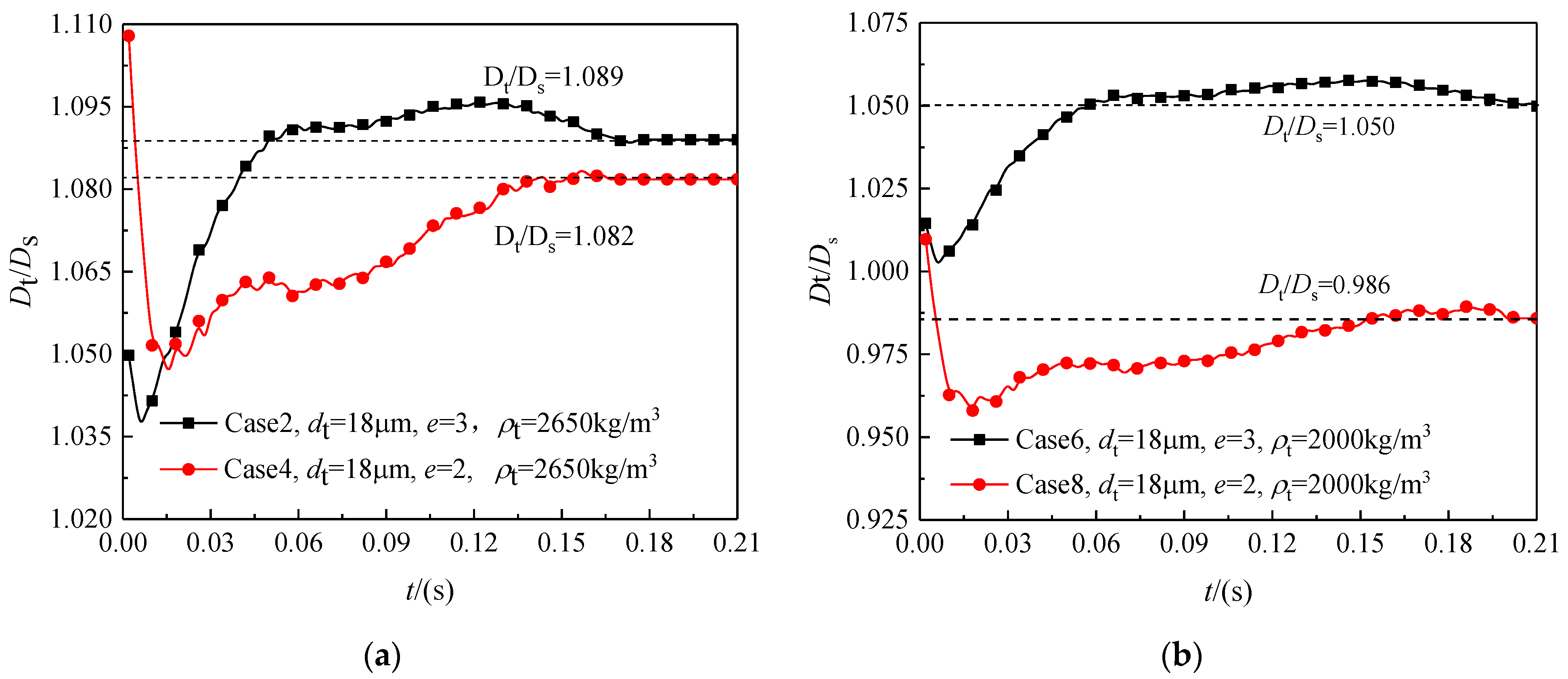
| Parameter | Symbol | Value | |||
|---|---|---|---|---|---|
| Case1 | Case2 | Case3 | Case4 | ||
| Particle-DEM | |||||
| Number | N | 1 | 955 | 1910 | 4775 |
| Concentration | c | 0 | 0.05 | 0.1 | 0.25 |
| Diameter/(m) | ds | 0.001 | 0.001 | 0.001 | 0.001 |
| Mass density/(kg/m3) | ρs | 2650 | 2650 | 2650 | 2650 |
| Stiffness/(N/m) | kn/kt | 500/143 | 500/143 | 500/143 | 500/143 |
| Damping/(N/ms) | γn/γt | 20,000/10,000 | 20,000/10,000 | 20,000/10,000 | 20,000/10,000 |
| Friction coefficient | μ | 0.4 | 0.4 | 0.4 | 0.4 |
| Fluid-CFD | |||||
| Mass density/(kg/m3) | ρf | 1000 | |||
| Viscosity/(m2/s) | v | 10−6 | |||
| Gravity (m/s2) | g | 9.8 | |||
| Domain dimensions | |||||
| Length/(m) | L | 0.01 | |||
| Wide/(m) | W | 0.01 | |||
| Height/(m) | H | 0.2 | |||
| Mesh size/(m) | 0.002 × 0.002 × 0.002 | ||||
| Parameter | Symbol | Value | ||||||||
|---|---|---|---|---|---|---|---|---|---|---|
| Diameter/(m) | D | 0.02 | ||||||||
| Particle size/(m) | d | 0.001 | ||||||||
| Reynolds number | Re | 141 | ||||||||
| Empirical coefficient | n | 3.8103 | ||||||||
| Particle concentration | c | 0 | 0.05 | 0.10 | 0.25 | 0.50 | 0.75 | 0.90 | 0.95 | 1.00 |
| Velocity/(m/s) | V(s,c) | 0.141 | 0.116 | 0.0944 | 0.0471 | 0.0101 | 0.000717 | 0.0000218 | 0.00000156 | 0 |
| Type | Type A | Type B | Type C | Type D | Test Condition | |
|---|---|---|---|---|---|---|
| Parameter | ||||||
| Installation depth/(m) | ≤15 | ≤25 | ≤35 | ≤50 | ||
| Drainage capacity/(1000 mm3/s) | ≥15 | ≥25 | ≥40 | ≥55 | Lateral pressure 350 kPa | |
| Permeability coefficient of membrane/(10 mm/s) | ≥5 × 10−4 | Immersed in water for 24 h | ||||
| Equivalent aperture diameter of membrane/(mm) | <0.075 | O95 | ||||
| Tensile strength of PVD/(kN/100 mm) | ≥1.0 | ≥1.3 | ≥1.5 | ≥1.8 | Elongation reached 10% | |
| Tensile strength of membrane/(N/10 mm) | Dry state | ≥15 | ≥25 | ≥30 | Elongation reached 10% | |
| Wet state | ≥10 | ≥20 | ≥25 | Immersed in water for 24 h when elongation reached 10% | ||
| Parameter | Symbol | Value | |||||||
|---|---|---|---|---|---|---|---|---|---|
| Particle—PVD membrane | |||||||||
| Number | 336 | ||||||||
| Diameter/(m) | d | 5 × 10−6 | |||||||
| Density /(kg/m3) | ρ | 500 | |||||||
| Particle—Slurry particle | |||||||||
| Case1 | Case2 | Case3 | Case4 | Case5 | Case6 | Case7 | Case8 | ||
| Number | 1751 | 1340 | 1400 | 1776 | 1751 | 1340 | 1400 | 1776 | |
| Diameter/(m) | ds | 1.0 × 10−5 | |||||||
| Density /(kg/m3) | ρs | 2650 | |||||||
| Void ratio | e0 | 3 | 3 | 3 | 2 | 3 | 3 | 3 | 2 |
| Slurry Thickness/(m) | h | 3 × 10−4 | 3 × 10−4 | 3 × 10−4 | 3 × 10−4 | 3 × 10−4 | 3 × 10−4 | 3 × 10−4 | 3 × 10−4 |
| Particle—Tracer particle | |||||||||
| Number | 20 | 12 | 5 | 12 | 20 | 12 | 5 | 12 | |
| Diameter/(m) | ds | 16 | 18 | 25 | 18 | 16 | 18 | 25 | 18 |
| Density /(kg/m3) | ρs | 2650 | 2650 | 2650 | 2650 | 2000 | 2000 | 2000 | 2000 |
| Particle—DEM | |||||||||
| Stiffness /(N/m) | kn/kt | 500/143 | |||||||
| Damping/(N/ms) | γn/γt | 20,000/10,000 | |||||||
| Friction coefficient | μ | 0.4 | |||||||
| Fluid—CFD | |||||||||
| Density/(kg/m3) | ρf | 1000 | |||||||
| Viscosity/(m2/s) | v | 1.0 × 10−6 | |||||||
| Gravity/(m/s2) | g | 9.8 | |||||||
| Domain dimensions | |||||||||
| Height/(m) | H | 4 × 10−4 | |||||||
| Width/(m) | W | 1 × 10−4 | |||||||
| Length/(m) | L | 1 × 10−4 | |||||||
Publisher’s Note: MDPI stays neutral with regard to jurisdictional claims in published maps and institutional affiliations. |
© 2021 by the authors. Licensee MDPI, Basel, Switzerland. This article is an open access article distributed under the terms and conditions of the Creative Commons Attribution (CC BY) license (https://creativecommons.org/licenses/by/4.0/).
Share and Cite
Wang, J.; Fu, Z.; Yu, Y.; Wang, G.; Shi, L.; Yuan, Z.; Yao, K.; He, J. Numerical Investigating on Representativeness of Tracers in PIV Model Test of Dredged Slurry Treated by Vacuum Preloading. Appl. Sci. 2021, 11, 9715. https://doi.org/10.3390/app11209715
Wang J, Fu Z, Yu Y, Wang G, Shi L, Yuan Z, Yao K, He J. Numerical Investigating on Representativeness of Tracers in PIV Model Test of Dredged Slurry Treated by Vacuum Preloading. Applied Sciences. 2021; 11(20):9715. https://doi.org/10.3390/app11209715
Chicago/Turabian StyleWang, Jiahao, Zunan Fu, Yanming Yu, Guoshuai Wang, Li Shi, Zhiying Yuan, Kang Yao, and Jie He. 2021. "Numerical Investigating on Representativeness of Tracers in PIV Model Test of Dredged Slurry Treated by Vacuum Preloading" Applied Sciences 11, no. 20: 9715. https://doi.org/10.3390/app11209715






